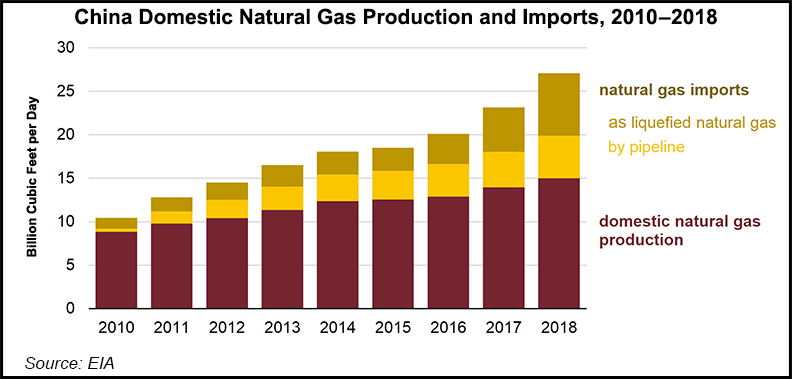E&P | NGI All News Access | NGI The Weekly Gas Market Report
China Moving to Boost Natural Gas Production as Imports Rise, Says EIA
The Chinese government has boosted subsidy programs to increase domestic production of natural gas in an effort to stifle rising imports, according to the U.S. Energy Information Administration (EIA).

“Rapid growth in China’s natural gas consumption has outpaced growth in its domestic natural gas production in recent years,” EIA said. “China’s natural gas imports, both by pipeline and as liquefied natural gas (LNG), accounted for nearly half (45%) of China’s natural gas supply in 2018, an increase from 15% in 2010…Natural gas production has recently grown in China largely because of increased development in low-permeability formations in the form of tight gas, shale gas, and to a lesser extent, coalbed methane (CBM).”
Last year, the Chinese State Council set a target of 19.4 Bcf/d for domestic natural gas production in 2020, a 29% increase from the country’s 2018 production average of 15.0 Bcf/d.
To increase domestic production, China has introduced incentives for several forms of production in the past few months.
The Chinese government introduced a subsidy program that established new incentives for gas production from tight formations, extended existing subsidies for production from shale and coalbed methane resources, and allowed foreign companies to operate independently in the country’s oil and natural gas upstream sector.
Production of tight gas, shale gas and coalbed methane collectively accounted for 41% of China’s total domestic natural gas production last year. “China has been developing tight gas from low-permeability formations since the 1970s, especially in the Ordos and Sichuan Basins,” EIA said. “Tight gas production was negligible until 2010, when companies initiated an active drilling program that helped lower the drilling cost per vertical well and improve well productivity.
China is forecast by some prognosticators to become the world’s third largest natural gas producer by 2027, but imports still could increase because of lower shale and CBM production. China’s CBM development is concentrated in the Ordos and Qinshui basins of the Shanxi province.
Shale gas development in China has focused on the Sichuan Basin, where China National Petroleum Corp. (CNPC) subsidiary PetroChina operates two fields and the China Petroleum and Chemical Corp. (Sinopec) operates another. The two companies have committed to produce a total of 2.13 Bcf/d of shale gas by 2020, which would double China’s 2018 shale gas production level, according to EIA.
CNCP and Sinopec increased their gas volumes in the first half of the year, in line with a government mandate to offset coal use. CNPC, the country’s largest producer, said recently its first half 2019 (1H2019) gas production increased 10% from the same period last year and accounted for 70.3% of China’s total gas production during the period. Sinopec said its 1H2019 gas production increased by 940 million cubic meters, a 6.8% increase from a year earlier.
© 2024 Natural Gas Intelligence. All rights reserved.
ISSN © 2577-9877 | ISSN © 1532-1266 | ISSN © 2158-8023 |
